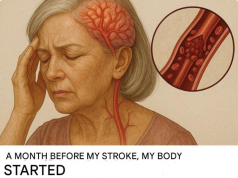Many people don’t realize that some of the earliest signs of diabetes can emerge during the night. These symptoms are often subtle and easily dismissed—blamed on stress, aging, or poor sleep habits. Yet, recognizing them early can be crucial for timely diagnosis and preventing long-term complications.
So, what happens in the dark when blood sugar levels go awry? Here are nine nighttime warning signs linked to diabetes:
1. Frequent Trips to the Bathroom (Nocturia)
If you’re waking up multiple times a night to urinate, it may not just be a bladder issue. High blood sugar forces your kidneys to work harder to filter out excess glucose, leading to increased urine production. This condition, known as polyuria, is one of the most common early signs of diabetes.
👉 Don’t ignore it: Waking up two or more times per night to pee could signal elevated blood sugar.
2. Night Sweats
Excessive sweating during sleep—soaking through clothes or sheets—isn’t always due to room temperature or menopause. In people with diabetes, night sweats can be a sign of nocturnal hypoglycemia (low blood sugar). When glucose drops too low, the body releases adrenaline, which triggers sweating as part of its emergency response.
👉 Key clue: Sweating accompanied by restlessness or confusion during the night.
3. Sudden Hunger or Palpitations at Night
Waking up with an intense craving for food, heart palpitations, or a racing heart may point to a blood sugar crash. Hypoglycemia during sleep can cause:
- Shakiness
- Anxiety
- Mental fog
- Sudden hunger pangs
These symptoms disrupt sleep and may indicate unstable glucose levels, especially in those already diagnosed with insulin resistance or diabetes.
4. Uncontrollable Urge to Move Your Legs
Restless legs syndrome (RLS) is more than just discomfort—it’s often linked to diabetic neuropathy, nerve damage caused by prolonged high blood sugar. People may feel tingling, crawling sensations, or deep leg tension that worsens at rest, making it hard to fall asleep or stay asleep.
👉 The connection: Up to 20% of people with type 2 diabetes experience RLS, often tied to poor glycemic control.
5. Snoring or Breathing Pauses During Sleep
Loud snoring or observed breathing interruptions during sleep could be signs of obstructive sleep apnea (OSA)—a condition strongly associated with type 2 diabetes. OSA is more common in individuals who are overweight or obese, populations also at higher risk for insulin resistance.
But it’s a two-way street:
Sleep apnea disrupts oxygen flow, increases stress hormones, and further destabilizes blood sugar, creating a dangerous cycle.
6. Intense Thirst & Dry Mouth Upon Waking
Waking up with a parched mouth and overwhelming thirst isn’t normal. This symptom, called polydipsia, occurs because high blood sugar pulls fluid from tissues, causing dehydration. The brain responds by triggering thirst to restore balance.
👉 Classic trio: Excessive thirst + frequent urination + dry mouth = red flags for diabetes.
7. Blurred Vision at Night
Some people notice blurry vision when getting up at night. Fluctuating blood sugar levels can cause the lens of the eye to swell temporarily, distorting focus. While this may resolve when glucose stabilizes, recurring episodes should prompt medical evaluation.
8. Tingling, Numbness, or Burning Sensations in Feet
Diabetic neuropathy often begins subtly, with nighttime tingling, numbness, or burning pain in the feet or legs. Since circulation slows at night, these sensations may become more noticeable when lying still.
👉 Early detection is key—nerve damage can be slowed with proper glucose management.
9. Poor Sleep Quality & Daytime Fatigue
Even after a full night’s sleep, people with uncontrolled blood sugar often wake up feeling exhausted. Blood sugar spikes and crashes interfere with deep sleep cycles, leading to non-restorative sleep and chronic daytime fatigue—a hidden hallmark of metabolic imbalance.
Why It Matters
These nighttime symptoms aren’t random inconveniences. They’re signals from your body that something is off. Left unchecked, untreated diabetes can lead to serious complications like heart disease, kidney failure, vision loss, and nerve damage.
The good news?
Early detection allows for lifestyle changes, monitoring, and treatment that can prevent progression.
What You Should Do
If you recognize any of these signs:
- Keep a symptom journal (note frequency and patterns)
- Consult your doctor about blood sugar testing (fasting glucose, HbA1c)
- Consider a sleep study if apnea is suspected
- Maintain healthy habits: balanced diet, regular exercise, weight management
Your nights shouldn’t be ruled by thirst, trips to the bathroom, or restless limbs.
While these symptoms may seem minor, together they form a pattern—one that could be pointing to diabetes.
And the power lies in awareness.
Because when you catch it early, you’re not just treating a condition…
You’re reclaiming your health—one quiet, restful night at a time.










